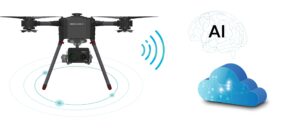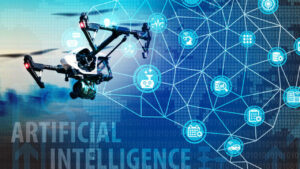The integration of artificial intelligence (AI) in drones has been a game-changer for the unmanned aerial vehicle (UAV) industry. With AI-powered drones, we can perform tasks that were previously impossible, impractical or too risky. In this article, From surveying to delivery, agriculture to search and rescue, drones equipped with Artificial Intelligence are enhancing the efficiency and accuracy of many industries.
Artificial intelligence in drones:
One of the primary advantages of Artificial Intelligence-powered drones is their ability to operate autonomously. By using machine learning algorithms, drones can analyze data from their sensors and make decisions on the fly without human intervention. This means they can fly pre-programmed routes, avoid obstacles, and make real-time adjustments based on environmental conditions.

For example, AI-powered drones can be used to inspect and maintain infrastructure such as bridges, pipelines, and power lines. They can be programmed to fly along the length of the structure, capturing images and data along the way. Using computer vision and machine learning algorithms, the drone can detect any anomalies, such as cracks or corrosion, and alert maintenance crews to perform necessary repairs.
Another area where Artificial Intelligence-powered drones are making a significant impact is in the agricultural sector. With the ability to survey crops and analyze data in real time, farmers can make more informed decisions about planting, fertilizing, and harvesting their crops. For example, drones equipped with hyperspectral cameras can capture images of crops that show the level of chlorophyll, water stress, and disease. AI algorithms can then analyze this data to determine which areas of the field require attention and optimize the use of resources.
Search and rescue operations are another areas where Artificial Intelligence-powered drones are proving valuable. Drones equipped with thermal imaging cameras and other sensors can quickly cover large areas of terrain and locate people who may be lost or injured. AI algorithms can analyze the images to detect any signs of human life and provide rescuers with the precise location of the individual.
In addition to these applications, Artificial Intelligence-powered drones are also being used in the delivery industry. With the rise of e-commerce, the demand for faster and more efficient delivery methods has increased. Companies like Amazon and UPS are using drones to deliver packages to remote areas or to supplement their traditional delivery methods.
One of the challenges with drone delivery is ensuring the safety of the drone and its payload. This is where AI-powered drones can make a significant impact. By using computer vision and machine learning algorithms, drones can detect obstacles in their path, adjust their flight path in real time, and safely land at their destination. This level of automation and accuracy is not possible with traditional remote-controlled drones.
The integration of Artificial Intelligence in drones has also led to advances in swarm intelligence. By coordinating the actions of multiple drones, swarm intelligence can achieve complex tasks that would be difficult or impossible for a single drone. For example, a swarm of drones could be used to map a large area in a short amount of time, survey a disaster zone, or even deliver supplies to remote areas.
Despite the many advantages of Artificial Intelligence-powered drones, there are also concerns about privacy and safety. As drones become more advanced and widespread, there is the potential for them to be used for nefarious purposes such as surveillance or as weapons. There is also the risk of accidents, such as drones colliding with buildings or other aircraft.
To address these concerns, there are regulations in place to govern the use of drones. For example, in the UK, drones weighing over 250g must be registered with the Civil Aviation Authority (CAA), and their pilots must hold a valid drone pilot certificate. There are also restrictions on where drones can be flown, such as near airports or over congested areas.
Conclusion
In conclusion, the integration of AI in drones has opened up new possibilities for many industries, from agriculture to search and rescue. By leveraging machine learning algorithms, drones can operate autonomously, perform complex tasks, and enhance safety and efficiency. However, it is important to consider the potential risks and concerns associated with the widespread use of AI-powered drones.

One way to mitigate these risks is through continued research and development of safety and privacy measures. For example, companies could invest in developing advanced collision avoidance systems, or create a framework for the ethical use of drones. Governments can also play a role in regulating drone use and ensuring that appropriate safety measures are in place.
Another important consideration is the ethical use of AI-powered drones. While they offer many benefits, there is also the potential for AI to be used in ways that violate people’s privacy or other ethical concerns. For example, facial recognition technology could be used to track individuals without their consent.
To address these concerns, it is important to have transparency and accountability in the development and deployment of AI-powered drones. This can include ensuring that algorithms are unbiased, providing clear guidelines for data collection and usage, and involving stakeholders in the decision-making process.
In summary, the integration of Artificial Intelligence in drones has the potential to revolutionize many industries, from agriculture to search and rescue. However, it is important to carefully consider the risks and concerns associated with the widespread use of AI-powered drones. By developing safety and privacy measures, promoting ethical use, and involving stakeholders in the decision-making process, we can ensure that AI-powered drones are used for the benefit of society.
Looking to the future, there is significant potential for Artificial Intelligence-powered drones to continue advancing and transforming industries. For example, the development of autonomous drone swarms could lead to more efficient delivery networks or the ability to perform complex tasks in hazardous environments. In addition, advances in machine learning and computer vision could further enhance the capabilities of drones, such as the ability to detect and respond to changing weather conditions.
One emerging application of Artificial Intelligence-powered drones is in the field of environmental monitoring and conservation. Drones equipped with sensors and cameras can be used to monitor wildlife populations, track changes in the environment, and detect illegal activity such as poaching or deforestation. AI algorithms can analyze the data collected by these drones, providing researchers and conservationists with valuable insights into the health and well-being of our planet.
Another area of potential is the use of drones for disaster response and recovery. In the aftermath of a natural disaster, drones can be used to quickly survey the damage, identify hazards, and locate survivors. AI algorithms can analyze the data collected by drones, helping emergency responders make more informed decisions about how to allocate resources and prioritize rescue efforts.
Finally, as technology continues to evolve, we may see AI-powered drones being used in ways that we cannot yet imagine. For example, drones could be used to perform tasks that are currently too difficult or dangerous for humans, such as inspecting nuclear reactors or exploring deep-sea environments. With each new application, the potential for AI-powered drones to enhance safety, efficiency, and innovation becomes clearer.
In conclusion, the integration of AI in drones has transformed the way we think about unmanned aerial vehicles. From agriculture to delivery, search and rescue to environmental monitoring, Artificial Intelligence-powered drones are enabling us to perform tasks in new and innovative ways.
As technology continues to advance, we can expect to see even more exciting applications of Artificial Intelligence-powered drones in the years to come. However, it is important to carefully consider the ethical and safety implications of this technology and to develop appropriate regulations and safeguards to ensure that AI-powered drones are used for the benefit of society.










